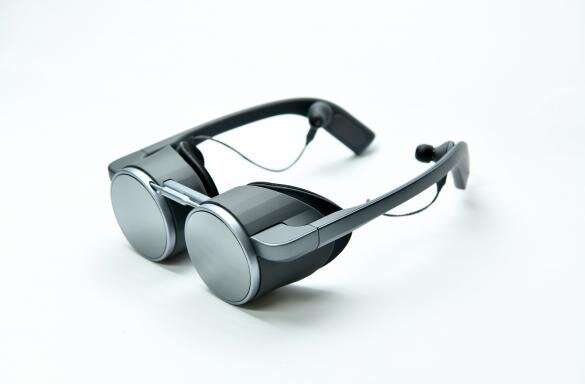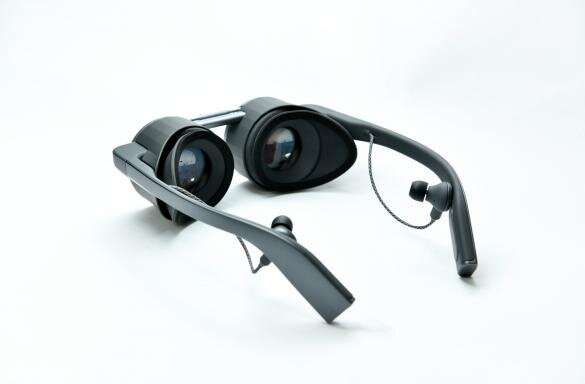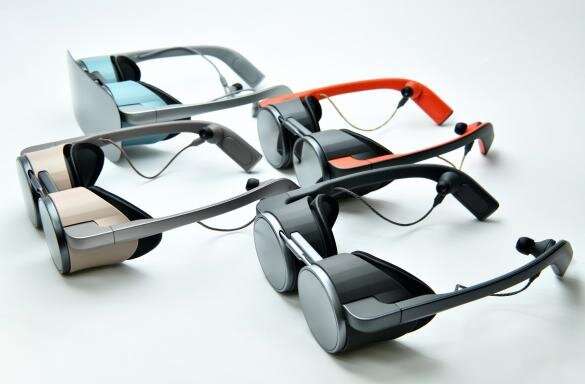January 14, 2020 weblog
Panasonic charms VR fans with aviator-style glasses

Panasonic's gift to CES 2020? Panasonic shades. For a very special function. Virtual reality. The talking point about their being showcased at the event is that they are glasses in shape.
"The problem with VR headsets," said Sam Byford in The Verge, "is that they still all look like VR headsets—glorified ski goggles that shut you off from the world."
Look ma, no headband. Look ma, no boxy nightmare (the boxy nightmare reference taken from SlashGear). The description via the Panasonic press release was that they were introducing the "High Dynamic Range (HDR) capable ultra-high definition (UHD) virtual reality (VR) eyeglasses."
Style-wise, Sam Byford in The Verge: "Basically, they're regular-ish glasses with a dash of steampunk aviator style."
Richard Lawler, senior news editor, Engadget, commented on demo reels that he saw.
"The company says that these are the first VR glasses to support HDR video, and in some of the demo reels I saw the advantages were apparent. One video showed high-res video of a beach captured from a drone, and in HDR a lot of annoying gradation in the sky disappeared and overall quality improved."
The Panasonic device certainly looked a lot more appealing than a standard VR headset, said Ars Technica.
Wareable gushed, "Virtual reality never looked so good."

Comfort and form factor no doubt have stood out as considerations in user experiences with VR. As Ars Technica posed, how appealing is a "ski-goggle-style headset design, which blocks almost the entire top half of your face with a large display rectangle held in place via headstraps or over-the-skull supports"?
It's not that conventional VR glasses cannot deliver high-quality images, high sound quality and immersive simulated experiences, but the glasses, said Panasonic, "tend to be big in size and require users to strap them to their head with a headband, which could cause wearer discomfort."
Panasonic's virtual reality eyeglasses are a result of collaborations with 3M and the Kopin Corporation.
Actually, the main features were listed in brief by Chris Burns in SlashGear:
(1) the micro OLED panels co-developed by Kopin and Panasonic (2) The optical module developed by Kopin and Panasonic along with 3M and (3) Technics original dynamic driver for sound.
Byford commented on the micro OLED panels that were co-developed by Panasonic and Kopin as showing "extremely high resolution with almost no hint of the 'screen-door effect that plagues most VR hardware."
(Panasonic boasted of smooth images without a "screen door effect," referring to "a visual artifact of displays, where the fine lines separating pixels become visible in the displayed image.")
Kyle Orland, senior gaming editor at Ars Technica, noted this was sporting HDR colors, "which could help make virtual worlds more vivid if they ever make it to an actual consumer product."

Reader comments on Ars Technica, meanwhile, showed concern about weight distribution.
"The weight is all forward, with no strap to help balance that," one comment said. "They might be all right for a use case where you're not moving your head much, but if you're moving around, they'll either fall off or the temples will be so tight as to be uncomfortable."
Another was on the same topic. "These look like they're designed by someone who has never actually used a VR headset for more than 5 minutes before. Weight distribution is incredibly important, which is why you need something to balance it properly on your head and keep the headset stable and secure."
In Wareable, Hugh Langley reported on finding it "hard to keep the goggles on our face, as their front-heavy design caused them to keep slipping down our nose." However, he said that "we also recognize that these are early in development, and Panasonic also let us try a wireless prototype that was much better balanced."
Other comments saw the glass half full: "Yes, there are likely 100 things wrong with them, but these are merely proof of concepts. We should focus on and be excited about the fact that this looks so different from existing headsets."
Panasonic stated that "Gearing up for the forthcoming full-scale commercial 5G services, Panasonic will continue to further develop the new VR glasses so that they can be used in a variety of applications, thereby creating new customer value."
Ormond: "Panasonic's efforts could be the first step in breaking down the major walls of comfort and form factor that are still preventing mass adoption of VR," he wrote. Byford said it was an intriguing look no matter what: "But my main takeaway from the demo was that hey, turns out it's possible to make VR glasses that are both better quality and with a better form factor. It might not make for a practical consumer product just yet, but it's an intriguing look at a step that could make VR technology more appealing to a mainstream audience."
Langley's parting verdict was that it was "unclear where the company will go with these, as it seems all possibilities are on the table. Here's hoping Panasonic eventually hones these into a VR headset we can use—and look damn good doing it."
© 2020 Science X Network



















